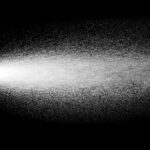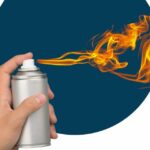Aerosol Testing: How to Choose the Right Flammability Test Method
By: Dana Mladin, SENIOR TECHNICAL CONSULTANT, email
If you have aerosol products that require flammability testing, but you’re confused about what specific testing requirements apply, you’ve come to the right place.
First, ask yourself, “Where am I selling the product”, “Who is using my product?”, and “Which regulation is applicable?”.
Next, think about the following:
- Will your aerosol products be sold in the USA, Canada, Europe, or Asia?
- Is your product a consumer, workplace, cosmetic or food product?
- Is your product used in the home, the workplace or both?
The answers will determine the necessary testing requirements for accurate hazard classification and labeling of your aerosol products.
Dell Tech’s ISO Accredited Lab and trained staff can assist you with aerosol testing as well as other testing services for hazard classification.
Overview of Flammability Test Methods for Aerosol Products
For all products used in workplace only (regulated by WHIMS 2015 in Canada and HCS/HazCom 2012 for US) or transported as Dangerous Goods (TDG for Canada, DOT for US, IATA for air and IMDG for Maritim), the use test methods as described in UN TDG Manual of Tests and Criteria Part III; Ignition Distance Test, Enclosed Space Ignition Test, and Aerosol Foam Flammability Test.
For US consumer products, the aerosol products are tested using the 16CFR1500.45 method for determining extremely flammable and flammable contents of self-pressurized containers.
For Canadian consumer products, the aerosol products will require testing as per the Consumer Chemicals & Containers Regulations (CCCR 2001) Schedule 1 -Test for Determining the Flashback and the Length of the Flame Projection of a Flammable Product Enclosed in a Spray Container.
For Canadian Food, Drug or Cosmetic products the aerosol dispensers will require testing using Official Method DO-30 Determination of Flame projection.
Many of our clients asked if they can use the results of tests from one jurisdiction to classify the product for all jurisdictions. Unfortunately, the answer is no.
Each regulation describes the method to be used and how to interpret the results, and there are significant differences between the methods and the interpretations of the results.
What all regulations have in common is that aerosol products are considered Dangerous Goods and require testing to classify appropriately.
Differences Between Aerosol Flammability Test Methods
Ignition Source Temperature
- US 16CFR1500.45 uses a 1” candle with a 2” flame.
- The Canadian methods use a propane burner with a 5 cm (2”) yellow flame.
- The UN TDG Ignition Distance Test uses a Bunsen burner with a 4 – 5 cm (1.5” – 2”) non-luminous flame.
The candle flame can easily be blown out by some aerosol products and therefore, no ignition will be observed. Whereas with the Bunsen burners, the same product will be ignited.
The UN TDG non-luminous flame burns hotter than the candle flame and the yellow gas flame. More ignition energy could ignite a higher boiling point solvent more easily.
Ignition Source Position
16CFR1500.45
The candle is situated at a fixed position, 6 inches from the actuator.
CCCR Schedule 1
The propane burner candle is situated at a fixed position, 15 cm from the actuator
UN TDG Ignition Distance Test
The Bunsen burner is moved in increments of 15 cm, starting at 15 cm from the actuator up to 90 cm, until no sustained combustion is observed.
Aerosol Can Position
16CFR1500.45
The instruction of use shall be strictly followed, including whether the dispenser is intended to be used in the upright or inverted position. When shaking is required, shake immediately before testing
CCCR Schedule 1
The instruction of use shall be strictly followed, including whether the dispenser is intended to be used in the upright or inverted position. When shaking is required, shake immediately before testing. When there are no instructions by the manufacturer respecting the shaking if the spray container, test the product with and without.
UN TDG Ignition Distance Test
The cans are to be tested in the upright and inverted position. When shaking is required, shake immediately before testing. The cans are tested when full and when 10 – 12% of nominal fill.
Interpretation of Results
16CFR1500.45
- Extremely Flammable– Flashpoint < 20 F (-6.7 C) and if flashback (a flame extending back to the dispenser) is observed at any degree of valve opening
- Flammable– flame projection exceeding 18 inches is obtained at full valve opening, or flashback (a flame extending back to the dispenser) is obtained at any degree of valve opening.
CCCR Schedule 1
- Very flammable– flashback (part of a flame projection that extends from the point of ignition back towards the spray container or flame projection 100 cm or more. The manufacturing, importation, advertising or sale of a spray product that has a flame projection of 100 cm or more is prohibited
- Flammable – a flame projection greater than 15 cm but less than 100 cm
UN TDG Ignition Distance Test
- Flammable Aerosol Category 1 (Extremely flammable) – Ignition occurs at a distance of 75 cm or more
- Flammable Aerosol Category 2 (Flammable) – Ignition occurs at a distance equal or greater than 15 cm but less than 75 cm.
- If no ignition occurs in the ignition distance test, the product must also be assessed using the Enclosed Space Ignition Test.
Aerosol Testing: Final Thoughts
In conclusion, the classification of an aerosol product can differ drastically depending on the method used.
For example, a product with a flame project of 100 cm or more (40 inches) and no flashback and ignites at 75 cm during the UN TDG Ignition Distance Test will have the following classifications:
- 45– Flammable;
- CCCR Schedule 1– Prohibited;
- GHS/UN TDG IDT – Flammable Aerosol Category 1 (Extremely flammable)
If you would like more information about your label requirements in Canada or the USA or help to choose the appropriate test method, talk to our team. Dell Tech Laboratories operates an ISO Accredited lab and our team is trained to perform all of the test methods mentioned above. We can help you test and classify your product for GHS, CCCR, or CPSC, and our excellent service includes reviewing the final report with your team to ensure you understand the results.








